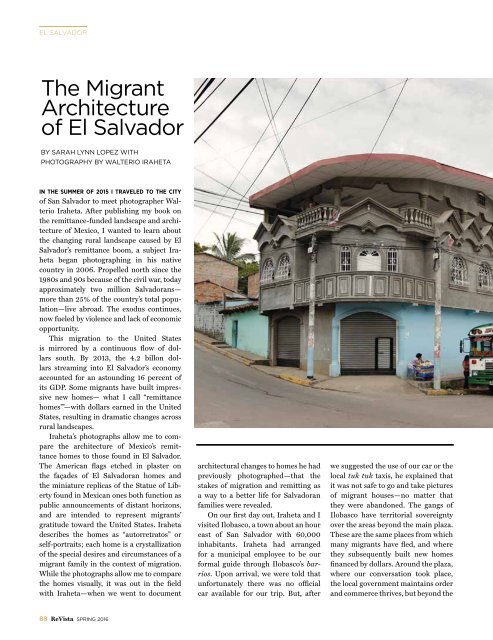EL SALVADOR
8clowSgZh
8clowSgZh
Create successful ePaper yourself
Turn your PDF publications into a flip-book with our unique Google optimized e-Paper software.
<strong>EL</strong> <strong>SALVADOR</strong><br />
The Migrant<br />
Architecture<br />
of El Salvador<br />
BY SARAH LYNN LOPEZ WITH<br />
PHOTOGRAPHY BY WALTERIO IRAHETA<br />
IN THE SUMMER OF 2015 I TRAV<strong>EL</strong>ED TO THE CITY<br />
of San Salvador to meet photographer Walterio<br />
Iraheta. After publishing my book on<br />
the remittance-funded landscape and architecture<br />
of Mexico, I wanted to learn about<br />
the changing rural landscape caused by El<br />
Salvador’s remittance boom, a subject Iraheta<br />
began photographing in his native<br />
country in 2006. Propelled north since the<br />
1980s and 90s because of the civil war, today<br />
approximately two million Salvadorans—<br />
more than 25% of the country’s total population—live<br />
abroad. The exodus continues,<br />
now fueled by violence and lack of economic<br />
opportunity.<br />
This migration to the United States<br />
is mirrored by a continuous flow of dollars<br />
south. By 2013, the 4.2 billon dollars<br />
streaming into El Salvador’s economy<br />
accounted for an astounding 16 percent of<br />
its GDP. Some migrants have built impressive<br />
new homes— what I call “remittance<br />
homes’”—with dollars earned in the United<br />
States, resulting in dramatic changes across<br />
rural landscapes.<br />
Iraheta’s photographs allow me to compare<br />
the architecture of Mexico’s remittance<br />
homes to those found in El Salvador.<br />
The American flags etched in plaster on<br />
the façades of El Salvadoran homes and<br />
the miniature replicas of the Statue of Liberty<br />
found in Mexican ones both function as<br />
public announcements of distant horizons,<br />
and are intended to represent migrants’<br />
gratitude toward the United States. Iraheta<br />
describes the homes as “autorretratos” or<br />
self-portraits; each home is a crystallization<br />
of the special desires and circumstances of a<br />
migrant family in the context of migration.<br />
While the photographs allow me to compare<br />
the homes visually, it was out in the field<br />
with Iraheta—when we went to document<br />
architectural changes to homes he had<br />
previously photographed—that the<br />
stakes of migration and remitting as<br />
a way to a better life for Salvadoran<br />
families were revealed.<br />
On our first day out, Iraheta and I<br />
visited Ilobasco, a town about an hour<br />
east of San Salvador with 60,000<br />
inhabitants. Iraheta had arranged<br />
for a municipal employee to be our<br />
formal guide through Ilobasco’s barrios.<br />
Upon arrival, we were told that<br />
unfortunately there was no official<br />
car available for our trip. But, after<br />
we suggested the use of our car or the<br />
local tuk tuk taxis, he explained that<br />
it was not safe to go and take pictures<br />
of migrant houses—no matter that<br />
they were abandoned. The gangs of<br />
Ilobasco have territorial sovereignty<br />
over the areas beyond the main plaza.<br />
These are the same places from which<br />
many migrants have fled, and where<br />
they subsequently built new homes<br />
financed by dollars. Around the plaza,<br />
where our conversation took place,<br />
the local government maintains order<br />
and commerce thrives, but beyond the<br />
88 ReVista SPRING 2016


